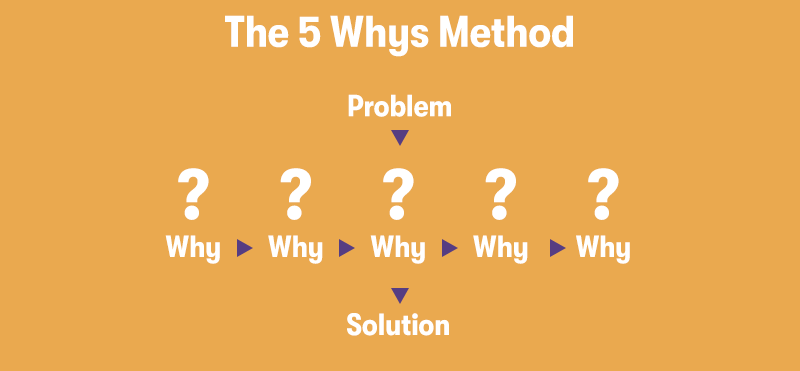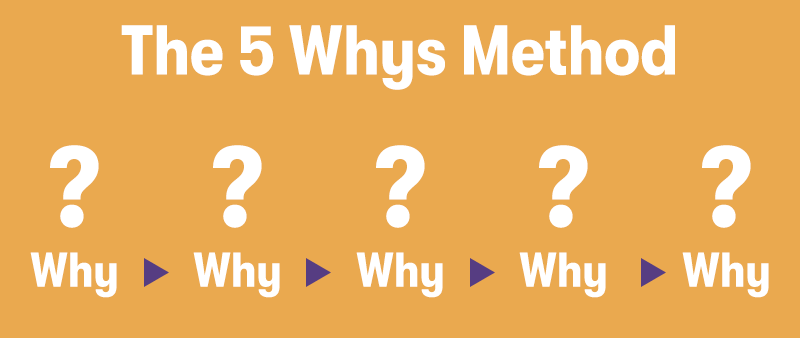Developed by Sakichi Toyoda at Toyota in the 1930s. It became integral to Toyota's manufacturing process and was later popularised globally as a fundamental component of problem-solving in Lean management. This method emphasises tracing issues back to their root causes through consecutive questioning, fostering more effective solutions.
This approach is now utilised across various industries for its depth in uncovering underlying issues and fostering a culture of inquiry and reflection.
The Five Whys Analysis is a simple yet impactful problem-solving method. This technique, which encourages asking "Why?" five times, helps identify the root cause of a problem, facilitating effective and sustainable solutions.
In this blog we will explore the methods application, benefits, and limitations, demonstrating how it can clarify and resolve complex issues.
What are The Five Whys?

The Five Whys is a problem-solving method that aims to identify the root cause of a problem by asking the question "Why?" five times in succession. This technique is grounded in the principle that problems are best solved by addressing their underlying causes rather than just their most immediate, visible symptoms. Here's a brief overview of how it works:
- Identify the Problem
- Ask Why
- Drill Down with More Whys
- Repeat Until the Root Cause is Identified
- Develop Countermeasures
The Five Whys technique is widely used in various fields, including business management, engineering, and quality control. It's particularly associated with lean manufacturing and the Toyota Production System, where it was formalised as a systematic problem-solving method. However, it can be applied in virtually any context where problems need to be resolved efficiently and effectively.
The strength of the Five Whys lies in its simplicity and focus on causality, but it also requires a disciplined approach to ensure that the true root cause is identified and not just symptoms or contributing factors. It's also beneficial to have a diverse team involved in the process to provide multiple perspectives on the problem and its possible causes.
The History of The 5 Whys Analysis
The Five Whys Analysis originated in the Japanese manufacturing sector, specifically within the Toyota Motor Corporation in the 1930s. It was developed by Sakichi Toyoda, the founder of Toyota Industries Co., Ltd., and further promoted by Taiichi Ohno, a key figure in the development of the Toyota Production System (TPS). The method was initially used as a critical component of Toyota's problem-solving training and its overall philosophy of continuous improvement, known as Kaizen.
Sakichi Toyoda, an inventor and industrialist, advocated for the importance of understanding the root causes of problems to prevent them from recurring. This principle was integral to the Toyota Production System, which aimed at eliminating waste, improving productivity, and ensuring quality in the manufacturing process. Taiichi Ohno, who is often called the father of the Toyota Production System, emphasised the importance of going beyond the surface-level symptoms to find the underlying causes of issues in the production line. The Five Whys Analysis was a practical tool to achieve this goal, making problem-solving a fundamental part of Toyota's operational excellence.
The Five Whys Analysis is deeply rooted in the Japanese philosophy of Kaizen, which focuses on continuous, incremental improvement. The simplicity of the method—asking "Why?" five times to get to the root cause of a problem—embodies the Kaizen spirit by engaging all employees in the problem-solving process and fostering a culture of improvement. It aligns with the broader principles of lean manufacturing by targeting inefficiencies and root causes of waste.
The success of Toyota and its reputation for high-quality manufacturing sparked interest in the company's methods worldwide. As companies and industries sought to replicate Toyota's success, the Five Whys Analysis became one of the many tools adopted globally as part of lean manufacturing, Six Sigma, and other quality management systems. Its simplicity and effectiveness in identifying root causes made it a popular choice across various sectors, not just in manufacturing but also in services, healthcare, IT, and more.
The Five Whys Method

The Five Whys Method is a systematic problem-solving technique used to explore the cause-and-effect relationships underlying a particular problem. The method involves repeatedly asking the question "Why?"—typically five times or until the root cause of the problem is identified. Here's a detailed step-by-step process of the Five Whys Method and its application:
Step 1: Start with a Problem
Clarification: Begin by clearly defining the problem. It's important that the problem is specific and factual, based on an actual event rather than a hypothetical situation. Documenting the problem with all relevant details can help ensure that everyone involved understands the issue at hand.
Example: A manufacturing line has a high defect rate in one of its products.
Step 2: Ask the First Why
Initial Exploration: Ask why the problem you've identified occurred. This first "Why?" seeks to find the immediate cause of the problem. The answer should be a straightforward observation that directly relates to the issue.
Example: "Why is the defect rate high?" Answer: "Because the machine calibration is off."
Step 3: Ask "Why?" Four More Times
Deep Dive: For each answer, ask another "Why?" This process digs deeper into the causal chain, moving from symptoms to underlying causes. It's important to base each answer on facts and evidence rather than assumptions or speculation.
Example: 2nd Why: "Why is the machine calibration off?" Answer: "Because the machine hasn't been maintained according to the schedule."
Step 4: Identify the Root Cause
Reaching the Core: The process of asking "Why?" should continue until no further logical answers can be found and you feel confident that you've uncovered the root cause of the problem. This is usually achieved by the fifth why but may occur earlier or require more inquiry.
Example: 5th Why: "Why hasn't the maintenance schedule been followed?" Answer: "Because the current scheduling system does not flag upcoming maintenance needs effectively."
Step 5: Develop Countermeasures
Solution Development: Once the root cause is identified, the next step is to develop countermeasures or actions that address this cause. The aim is to implement a solution that prevents the problem from recurring rather than merely treating the symptoms.
Example: Implement a new maintenance scheduling system that automatically alerts the maintenance team of upcoming tasks and tracks compliance.
Applying the Five Whys Method Effectively
Documentation: Throughout the process, document each question and answer. This record-keeping is valuable for understanding the reasoning behind each step and for future reference.
Team Involvement: Engage a cross-functional team in the process if possible. Different perspectives can lead to a more comprehensive understanding of the problem and more robust solutions.
Action and Follow-Up: After developing countermeasures, it's crucial to implement them, monitor their effectiveness, and adjust as necessary. The true value of the Five Whys Method is realised when it leads to actionable improvements that prevent problem recurrence.
By meticulously following these steps and principles, the Five Whys Method can be a powerful tool for root cause analysis and problem-solving across a wide range of contexts.
5 Why Example

Let's explore an example of applying the Five Whys Method in the context of IT Service Management (ITSM), focusing on a common issue: a critical application's frequent downtime.
Problem Statement
A critical business application experienced unexpected downtime three times in the past month, affecting customer transactions and leading to significant business impact.
1st Why
Question: Why did the critical application experience unexpected downtime?
Answer: The application crashed due to an out-of-memory error.
2nd Why
Question: Why did the application run out of memory?
Answer: The application's memory usage exceeded its allocation because it was not efficiently managing memory.
3rd Why
Question: Why was the application not efficiently managing memory?
Answer: The application contained a memory leak that had gone undetected.
4th Why
Question: Why did the memory leak go undetected?
Answer: The monitoring tools in place did not effectively alert the team to the memory leak.
5th Why
Question: Why did the monitoring tools not alert the team to the memory leak?
Answer: The monitoring tools were not configured to track or alert on the specific type of memory allocation and usage that led to the leak.
Root Cause
The root cause of the critical application's unexpected downtime was that the monitoring tools were not configured to detect the specific type of memory leak that occurred.
Developing Countermeasures
To prevent future downtime, the following countermeasures could be implemented:
Update Monitoring Configuration: Enhance the monitoring tool's configuration to include alerts for unusual memory allocation patterns and potential memory leaks.
Memory Leak Detection and Correction: Conduct a thorough review of the application to identify and fix memory leaks. Implement regular code reviews and testing to detect potential memory management issues before they affect production.
Training and Best Practices: Provide training for the development and operations teams on best practices for memory management and the importance of proper monitoring tool configuration.
Periodic Review of Monitoring Tools and Configurations: Establish a routine for periodically reviewing and updating monitoring tools and configurations to ensure they remain effective as the IT environment and application requirements evolve.
By addressing the root cause through these countermeasures, the organisation can significantly reduce the likelihood of unexpected application downtime, improving reliability and customer satisfaction.
The Benefits of the 5 Whys

The Five Whys method, by virtue of its simplicity and directness, offers a range of benefits that make it a powerful tool for problem-solving and continuous improvement in various domains, including business processes, manufacturing, and service delivery. Here are some of the key benefits:
Simple and Easy to Use
The method doesn't require statistical analysis, special training, or sophisticated tools, making it accessible to everyone in an organisation. Its simplicity encourages more people to engage in problem-solving activities.
Promotes Root Cause Analysis
By focusing on the root cause of a problem rather than its symptoms, the Five Whys helps organisations implement solutions that are more likely to prevent recurring issues, leading to more durable and effective fixes.
Encourages Deep Thinking
It pushes individuals and teams to think deeply about a problem, challenging assumptions and uncovering underlying issues that might not be immediately apparent.
Improves Processes
Regular application of the Five Whys can lead to improvements in processes and systems by systematically eliminating underlying problems, contributing to higher quality and more efficient operations over time.
Enhances Team Involvement
Involving a team in the Five Whys process can foster collaboration and collective ownership of problems and solutions. It encourages a culture of transparency and continuous improvement, where all team members are empowered to contribute their insights and expertise.
Cost-Effective
Since the Five Whys doesn't require expensive tools or technology, it's a cost-effective way to solve problems. By preventing the recurrence of problems, it can also save organisations money in the long term.
Fast and Efficient
The method can quickly lead to the identification of a root cause, allowing for rapid development and implementation of solutions. This efficiency is particularly beneficial in environments where swift action is required to resolve issues.
Versatility
The Five Whys can be applied in a wide variety of settings and industries, from manufacturing and healthcare to IT and service sectors. It is adaptable to almost any problem-solving situation.
Promotes Learning and Insight
Through its iterative questioning process, the Five Whys method promotes learning and provides insights into how systems and processes work. This can be invaluable for new team members or for organisations looking to deepen their operational knowledge.
Facilitates Preventative Measures
By identifying and addressing the root cause of issues, the method helps in developing preventative measures that can reduce the likelihood of future problems, leading to more stable and reliable operations.
Overall, the Five Whys is a powerful method for fostering a culture of continuous improvement, encouraging teams to look beyond surface-level symptoms and tackle the underlying causes of problems, leading to more sustainable and effective solutions.
The limitations of the 5 Why Analysis

While the Five Whys analysis is a powerful and straightforward tool for root cause analysis, it has limitations that can affect its effectiveness in certain situations. Understanding these limitations can help organisations apply the method more judiciously and effectively:
Oversimplification of Complex Problems
The Five Whys can oversimplify complex issues that have multiple root causes. Because it tends to linearly follow a single causal path, it may not adequately address problems that arise from interrelated factors.
Subjectivity and Bias
The process can be highly subjective, relying heavily on the insight and experience of the individuals involved. This can lead to bias in identifying root causes, especially if participants have preconceived notions about the problem's source.
Lack of Depth in Analysis
Without thorough investigation and evidence, the method might lead to a superficial understanding of the problem. It risks stopping at symptoms rather than truly digging into the underlying causes if the questioning is not rigorous enough.
Potential for Incorrect Conclusions
If the analysis is not grounded in data and evidence, there's a risk of reaching incorrect conclusions. Misidentifying the root cause can lead to ineffective solutions that don't prevent problem recurrence.
Reliance on Expert Knowledge
Effective use of the Five Whys often depends on having participants with deep knowledge of the process or system being analysed. Without expert insight, the analysis may not reach the true root cause.
Not Always Quantifiable
The qualitative nature of the Five Whys makes it challenging to quantify problems and solutions. In situations where statistical analysis is crucial for understanding the problem, the Five Whys might need to be supplemented with other tools.
May Not Identify All Root Causes
For problems with multiple root causes, the Five Whys might focus too narrowly on one aspect, missing other critical underlying issues. This can lead to partial or temporary solutions.
Can Lead to Solution Jumping
There's a temptation to jump to solutions after identifying what seems to be a root cause, sometimes prematurely. This can prevent a thorough exploration of the problem and potential solutions.
Requires Effective Facilitation
The process can be derailed by ineffective facilitation, such as leading questions or failure to challenge assumptions. A skilled facilitator can help ensure that the analysis is comprehensive and unbiased.
Potential for Demotivation
If used incorrectly, the method can sometimes be perceived as a tool for assigning blame, which can demotivate team members and create a culture of fear rather than one of open communication and continuous improvement.
To mitigate these limitations, it's often recommended to use the Five Whys in conjunction with other problem-solving tools and techniques, especially for complex or critical issues. Ensuring that the process is inclusive, evidence-based, and well-facilitated can enhance its effectiveness and lead to more reliable and comprehensive solutions.
Where to Learn More About Problem Management and Root Cause Analysis?
Our Problem Management & Root Cause Analysis Techniques Workshop will teach you which techniques are most useful for different types of problems and when it's appropriate to undertake root cause analysis. You will also identify barriers to effective problem solving and how to overcome them and information gathering techniques.
Click here to learn more about our Problem Management & RCA Workshop.
Final Notes on 5 Why Analysis
In conclusion, the Five Whys, despite its simplicity, it helps teams identify root causes and create enduring solutions, though it has limitations in complex scenarios.
As businesses strive for excellence, the Five Whys highlights the importance of asking the right questions to achieve deeper understanding and effective problem resolution.
Remember, always involve diverse team members in the questioning process. This approach ensures that multiple perspectives are considered, which can uncover deeper insights into the root causes of a problem, leading to more effective solutions.


